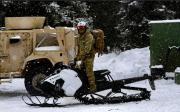
Originally Posted by
Trigger

So I have a question to ask all of you smarter than me types. Is the Army's logistic system sophisticated enough to support more than one rifle and more than one caliber? Serious question. Wouldn’t it be nice if the Army could train for marksmanship in general. Then when they go into a conflict dominated by open spaces and long shots, they issue a weapon and ammunition optimized for that. When they go into a conflict dominated by urban warfare, they issue a weapon and ammunition optimized for that. You get the picture.
I understand SOF can do that now. My question is can big Army and big Marine Corps support system of training and logistics be flexible enough and sophisticated enough to support more than one rifle and caliber? This might mean something along the lines of a lightweight Ruger SFAR in 6.5 or 6.8 for longer distances, and an AR15 with 556 or 300 BLK for more urban situations.
Both 100 years ago and 50 years ago; it was one rifle one caliber. All training, all scenarios. Today might be different. Certainly when I go hunting I don’t choose one rifle for all animals: Elk, Bear, deer, coyotes, prairie dogs. Certainly SOF can tailor their gear and load out to their specific mission. Traditionalists would say no, the logistic challenges and cost for big Army/Marines would outweigh the benefits. But on the other hand, the Marines have experimented with Agile logistics and additive manufacturing, deploying the capability to create spare parts in the field when the logistics tail is too long to support them efficiently.
If we can do this, the simple answer becomes buy both systems. Buy a long range caliber for one scenario, buy a short range caliber for another. Create the commonalities in weapons shape, operation, magazines, safeties, malfunction clearance, such that there are minimal training scars when moving from one system to another. Ruger SFAR in 6.5/6.8 and AR-15 in 556/300BLK.
We had an expression when I was working budgets, requirements, planning and programming on the Staff, called POM dust. Compared to the cost of a new major weapon system like an airplane or a ship, the cost of a rifle system is insignificant: dust. If we can control the logistics cost of having two or three complementary rifles and calibers, then the logistics does not hold us back. Instead of having one rifle to rule them all, we have two or three tailored for each scenario. If the logistics is flexible and agile, then two or three rifles and calibers would actually be cheaper in the long run than one rifle they can do it all.
The question is, can we do it?




 Reply With Quote
Reply With Quote




